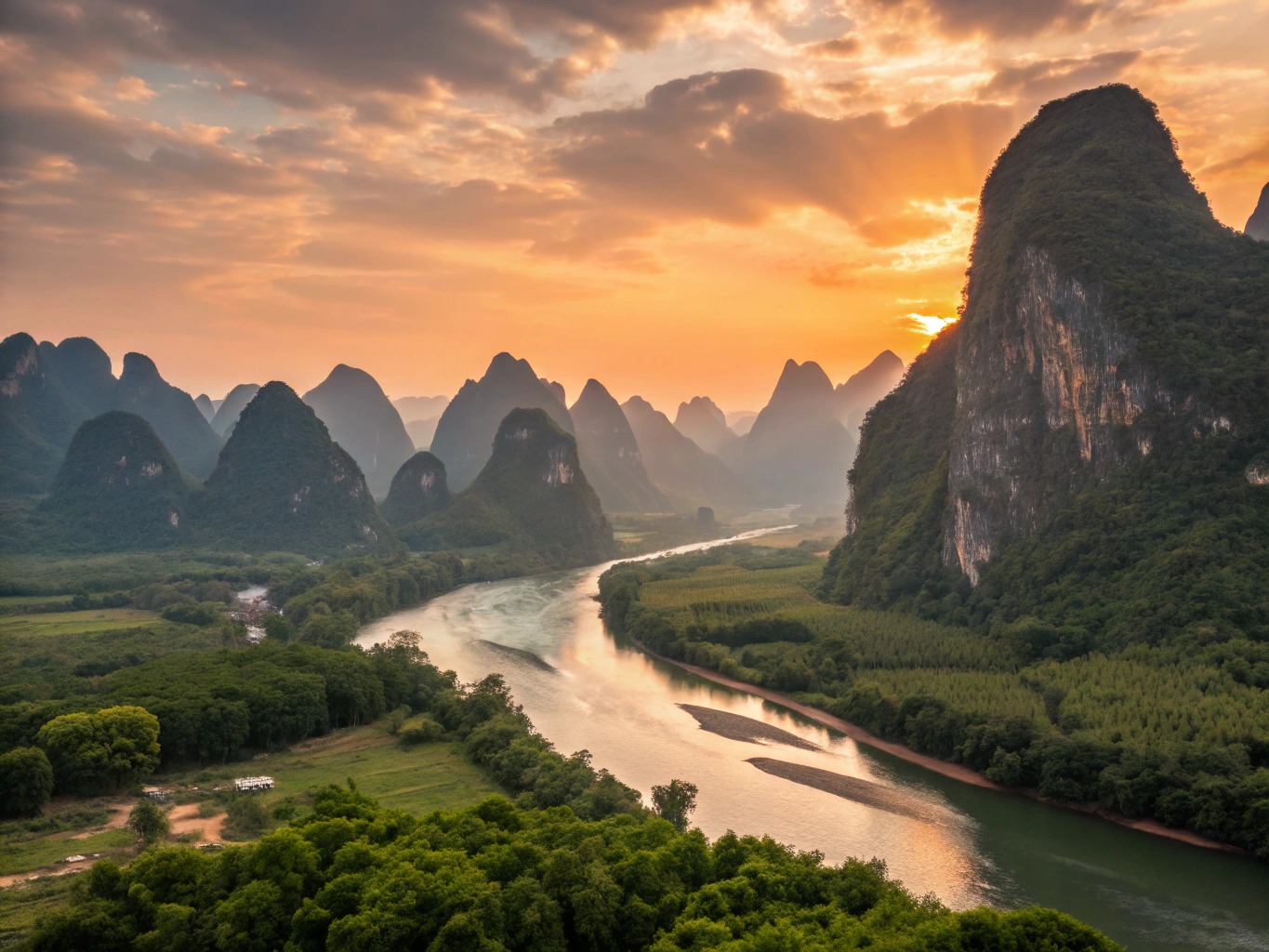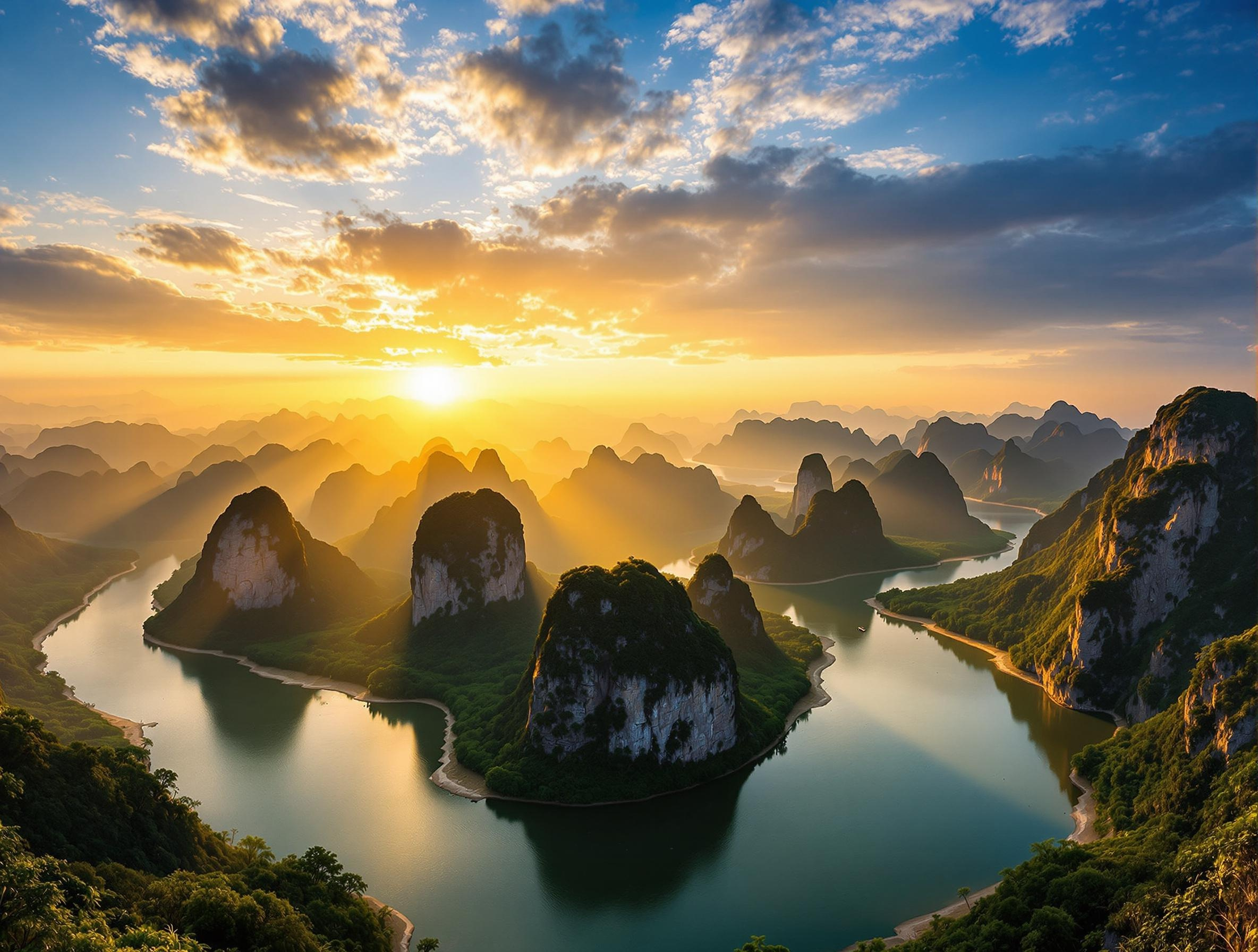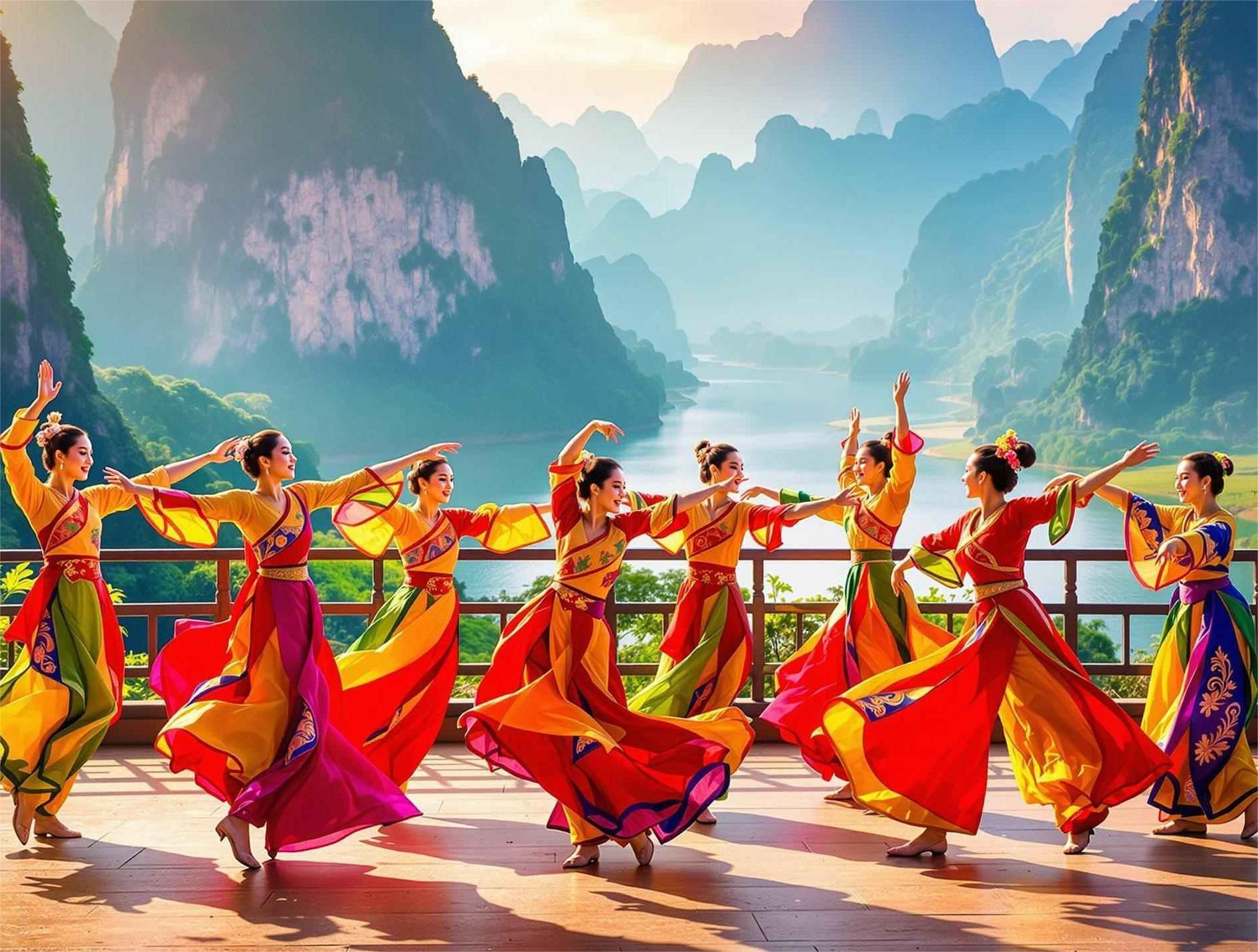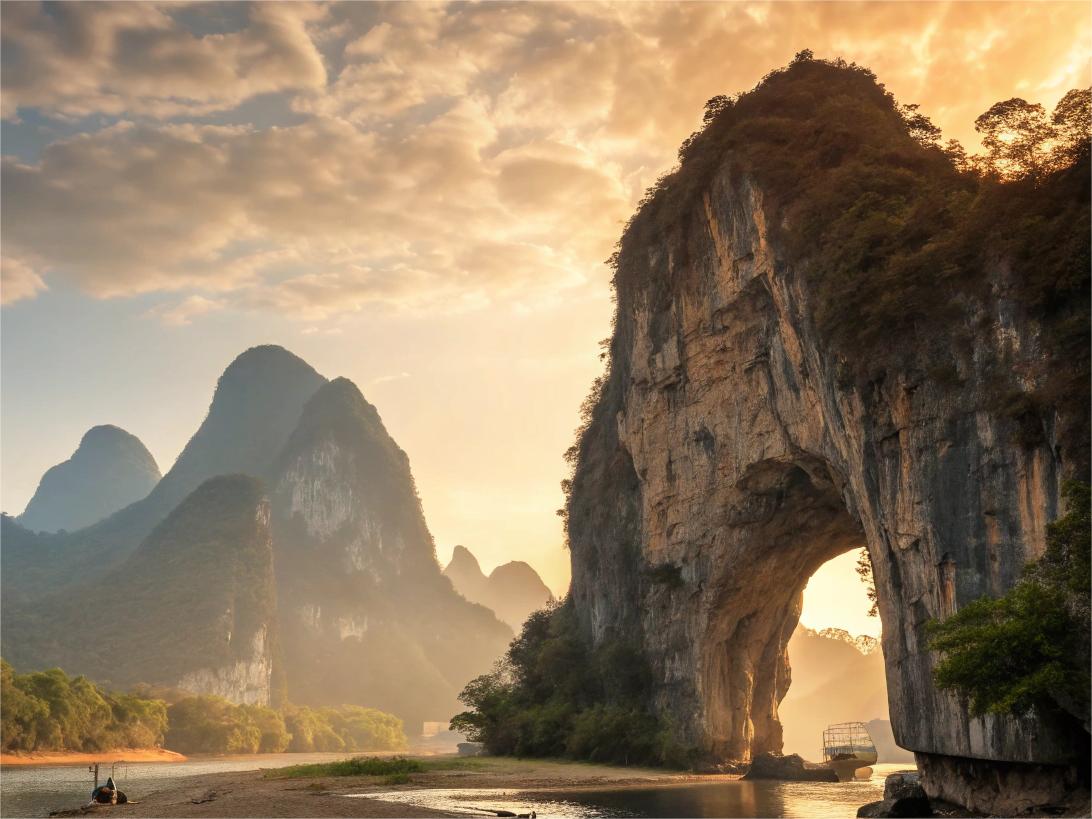Li River— The Li River, located in the northeastern part of Guangxi Zhuang Autonomous Region in China, is a tributary of the Xijiang River in the Pearl River system, also known as the Guijiang section. It originates from Mao'er Mountain, known as the "First Peak of South China," and flows through Guilin and Yangshuo, merging with the Lipu River at Gongcheng Estuary in Pingle County to form the Guijiang River. The river stretches approximately 437 kilometers, with the 83-kilometer section from Guilin to Yangshuo being renowned for its picturesque scenery, earning the title "Gallery of a Hundred Miles."

Natural Scenery and Geographical Features
The Li River is famous for its "green mountains, clear waters, unique caves, and beautiful rocks," representing a typical karst landscape. The riverbanks are lined with towering peaks, creating a diverse and majestic landscape; the water is crystal clear, winding and twisting like a jade ribbon weaving through the peaks. The river surface is dotted with various sandbanks and bamboo groves, forming stunning landscape paintings.
The Li River is part of the Pearl River system and is renowned for its unique karst landscape (karst topography is a special type of landscape formed by the dissolution of soluble rocks, mainly including limestone, dolomite, and gypsum, under the action of water. This unique landscape is known for its diversity of surface and underground forms, making it one of the most peculiar natural landscapes on Earth). The banks are characterized by overlapping peaks and unique formations, creating the world-famous "Guilin scenery is the best under heaven."
Main Features
Crystal clear river water; Rolling limestone peak forests; Meandering river channels; Rich and diverse ecosystems

Touring the Li River (How to reach Guilin can be found in this article)
Cruise Docks: The classic way to tour the Li River is by taking a cruise from Mopanshan Dock in Guilin to Yangshuo. You can reach Mopanshan Dock by taxi or tourist shuttle bus from the city center.
Bamboo Rafting: For a bamboo rafting experience, you can start from Yangdi Dock or Xingping Dock, accessible by local tourist buses or private hire.
Public Transportation: Guilin City has multiple bus routes and tourist shuttle buses that conveniently reach major attractions and docks.
Cultural and Historical Aspects of the Li River: The Li River's beautiful scenery has attracted countless poets and scholars. Tang Dynasty poet Han Yu and Song Dynasty writer Su Shi both wrote poems praising its beauty. These poems not only record the natural landscape of the Li River but also imbue it with rich cultural significance.
The Li River basin is home to diverse ethnic cultures, including the Zhuang, Yao, and Miao peoples, with various forms of folk art such as singing, dancing, embroidery, and silverware. These art forms reflect the cultural diversity of the Li River basin.

Li River Fishing Lights: Over four hundred years ago, fishermen in Yangshuo, Guilin, began training cormorants to catch fish. At nightfall, fishermen would board bamboo rafts, light torches, and take several cormorants with them, calling out to attract fish. The cormorants would dive into the water, catching fish one after another. The fishing lights on the river surface flickered like fireflies, accompanied by the sound of fishing songs, creating a captivating night fishing scene. This traditional fishing method, passed down for centuries, is known as Li River Fishing Lights.
In the past, fishermen on the Li River would often go night fishing with dozens or even hundreds of bamboo rafts gathering in the Baisha River Bend. Fishermen would light fishing lamps on the rafts to lure fish. The twinkling fishing lamps and splashing water resembled stars in the night sky, illuminating the bamboo rafts and the cormorants diving in and out of the water, creating a breathtaking spectacle.


Main Attractions
Nine Horses Fresco Hill: One of the famous attractions on the Li River, where nine galloping horses can be vaguely seen on the mountain, hence the name. It is said that those who can see all nine horses possess extraordinary wisdom.
Yellow Cloth Reflection: Located near Yangshuo County, the water here is as calm as a mirror, reflecting the Yellow Cloth Hill, creating a mesmerizing scene.

Diecai Hill: Known for its unique geological structure and seasonal color changes, it is one of the best places to view the panoramic scenery of the Li River. The hill is rich in cliff inscriptions by famous figures from various dynasties, representing the essence of cultural relics. Climbing to Mingyue Peak and standing at Nayun Pavilion offers a full view of the city. "A breeze on one side, mountains on four sides, it seems like a fairyland on earth." The name Diecai Hill comes from a record by Yuan Hui, the nephew of Tang Dynasty poet Yuan Zhen, who visited Diecai Hill and wrote "Record of Diecai Hill," stating: "According to the map, the mountain is named for its horizontal stone patterns, interspersed with colorful greens, like stacked brocades, hence the name." The hill's rocks resemble brocade silk, layered and stacked, giving it its name. From the right corner of Diecai Pavilion, built by Qing Dynasty scholar Qin Huan, one can see the horizontally cut cliff of Mingyue Peak, resembling "colorful brocade." This is the best angle for photographing "Diecai."
Elephant Trunk Hill Scenic Area: Located in the central area of Guilin City, Guangxi Zhuang Autonomous Region, on the west bank of the Li River, it is the most representative landmark of Guilin. This park, listed as one of the first national 5A-level scenic spots, is famous for its unique mountain shape resembling an elephant drinking water with its trunk, known as the symbol of "Guilin Scenery." The main peak of Elephant Trunk Hill is about 200 meters high, composed of limestone typical of karst topography. After millions of years of geological movement and water erosion, it has formed this rare natural wonder. The large through-hole (Shuiyue Cave) at the junction of the mountain and the Li River, along with the overall mountain shape, forms the world-famous "elephant trunk" shape.

Legend of Elephant Trunk Hill: Long ago, there was a divine elephant in the heavenly court, a powerful assistant to the Heavenly Emperor. This divine elephant was attracted by the beautiful scenery of Guilin and secretly descended to the mortal world to play. In the human world, I met a kind village girl and was moved by the villagers' hard lives. The divine elephant decided to stay and help the villagers, using its long trunk to draw water from the Li River day and night to irrigate the fields. However, its actions angered the Heavenly Emperor. In a fierce battle with celestial soldiers, the divine elephant chose to transform into a mountain, forever guarding this land and its people.
Xingping Ancient Town: With a history of over a thousand years, it is one of the most classic spots to view the Li River, once featured on the background of the 20-yuan banknote.
Precautions
Checking the weather in advance is recommended to avoid traveling during the rainy season. It is best to bring rain gear and sun protection when sightseeing on a cruise. Respect local culture and customs, especially in areas inhabited by ethnic minorities.
Summary
The Li River, with its beautiful natural scenery, rich cultural heritage, and diverse ethnic customs, has become one of China's most charming tourist destinations. Whether quietly admiring the green mountains and clear waters on both sides or immersing oneself in the cultural atmosphere here, the Li River offers visitors an unforgettable experience.
